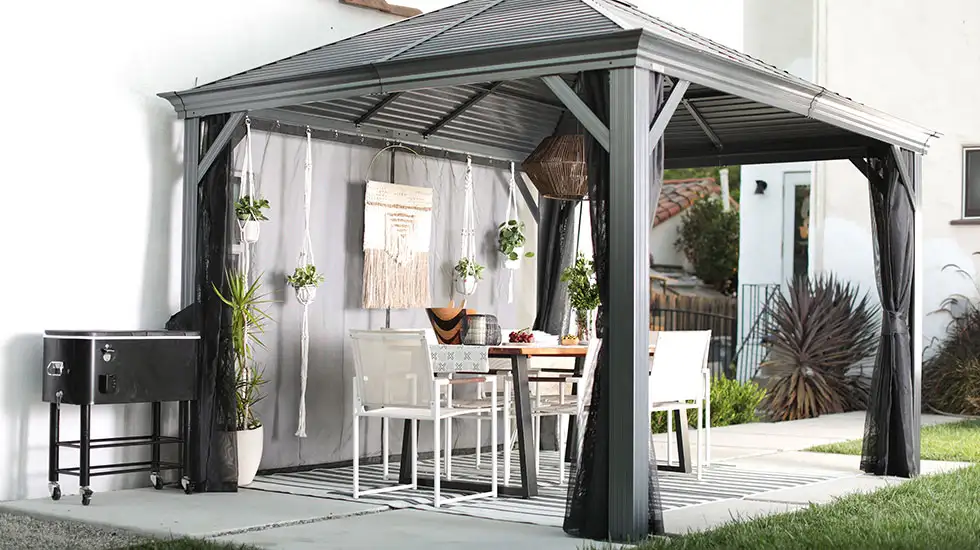What is a Gazebo?
A gazebo is a garden or backyard structure designed to provide a shaded outdoor space for relaxation and entertainment. It is typically an open-sided, octagonal or hexagonal building with a roof and a raised floor. Gazebos can vary in size and style, from small, simple ones that have only a few seats, to larger, ornate structures with intricate design details and seating for several people.
Gazebos are often used for outdoor gatherings, such as weddings, family reunions, barbecues, and parties. They can also serve as a quiet retreat for reading, meditation, or enjoying the scenery. Gazebos come in many different types, including permanent structures that are anchored to the ground, and portable ones that can be moved from one location to another.
The design of a gazebo depends on personal preferences and the intended use of the structure. Gazebos can be made from a range of materials, including wood, steel, or aluminum. Wood gazebos are popular as they provide a warm and natural look and blend well with the surrounding environment. Steel and aluminum gazebos, on the other hand, are more durable and resistant to the elements.
The choice of roof for a gazebo is also an important consideration. Hardtop gazebos have a sturdy, solid roof that provides year-round protection from the elements. Soft-top gazebos, on the other hand, have a canopy that can be removed or replaced depending on the weather conditions.
Overall, gazebos are a great addition to any outdoor living space, providing shade, shelter, and a touch of elegance to your backyard. Whether you prefer a permanent or portable gazebo, choosing the right type for your needs and taking into account factors such as wind conditions, roof type, and anchoring methods, can help ensure that your gazebo remains a stable and enjoyable feature of your garden for years to come.
Can a Gazebo Go on a Patio?
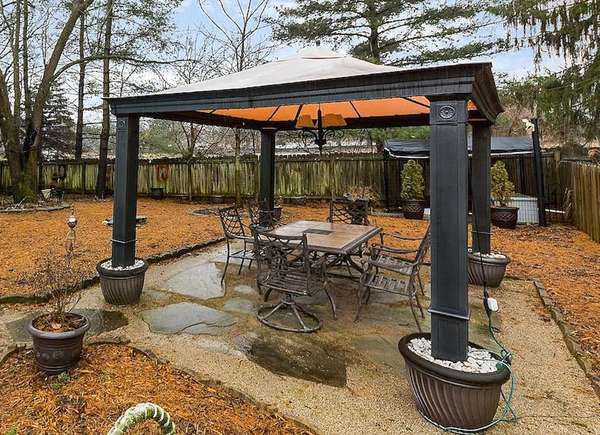
When it comes to outdoor living spaces, gazebos are a popular addition that can provide a comfortable and aesthetically pleasing space for all kinds of occasions. But if you have a patio, you may be wondering whether it’s possible to add a gazebo on it. The answer is yes, it’s possible – as long as you take a few factors into consideration.
The first thing to consider is the type of gazebo you want to install. Gazebos come in many shapes and sizes, from permanent structures to temporary canopies. For a patio, a freestanding or anchored gazebo is likely the best option. This type of gazebo can be installed directly on the patio surface or anchored into the ground around it.
If you plan to install a permanent gazebo on your patio, you’ll need to make sure that it is secured to the ground in a way that can withstand any inclement weather conditions. Use heavy plant pots or weight bags to anchor the legs of the gazebo, or secure it into the patio surface with masonry screws or metal straps.
For a temporary or pop-up gazebo, weight bags or sand-filled bags can be used to secure the structure. These bags can be placed on the corners or legs of the gazebo to prevent it from moving in the wind. Just make sure to choose a weight that is appropriate for the size and weight of the gazebo.
Another thing to keep in mind is the weight of the gazebo. Some permanent gazebos can be quite heavy, and if you’re planning to install one on a wooden patio, you may need to reinforce the structure to support the weight. For a concrete patio, on the other hand, you don’t need to worry as much about the weight of the gazebo.
Ultimately, whether a gazebo can be installed on a patio depends on the type of gazebo, the patio surface, and the amount of wind or other inclement weather that the structure will be exposed to. But with careful planning and proper installation, a gazebo can be a great addition to any outdoor living space.
Types of Gazebos
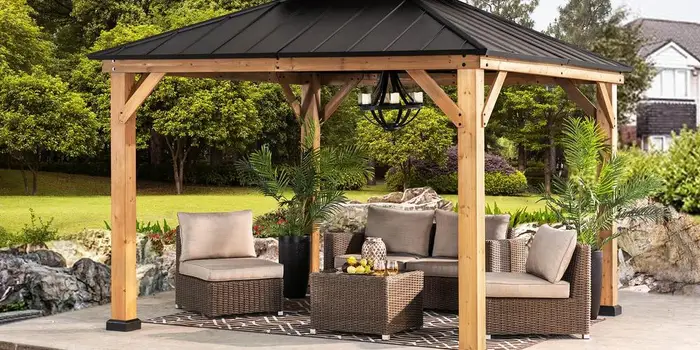
Gazebos are versatile outdoor structures that can add a touch of elegance and comfort to any backyard space. They come in different sizes, shapes, and styles, and can be made of various materials such as wood, metal, vinyl, or fabric. Each type of gazebo has its own unique features and advantages, and choosing the right one depends on your personal preferences, budget, and intended use. In this article, we’ll discuss some of the most common types of gazebos and their characteristics.
1. Wooden gazebos – Wooden gazebos are classic and timeless structures that add a charming rustic vibe to any outdoor living space. They are usually made of high-quality, durable wood species such as cedar, redwood, or pine, which can withstand the elements and resist rot and decay. Wooden gazebos can be left natural or stained or painted to match the surroundings. They can have different roof styles, such as a simple hip or gable roof or a more elaborate pagoda or cupola roof.
2. Metal gazebos – Metal gazebos are sturdy and durable structures made of steel or aluminum. They can be powder-coated in various colors or finishes, making them low-maintenance and weather-resistant. Metal gazebos can have a hardtop or a soft-top roof, and can come in different shapes and sizes, from hexagonal to rectangular to oval.
3. Vinyl gazebos – Vinyl gazebos are stylish and modern structures that offer the look and feel of wood but require less upkeep. They are made of vinyl or PVC materials that are resistant to dirt, fading, and insects. Vinyl gazebos are available in different styles and colors, and can be easily assembled and disassembled.
4. Pop-up gazebos – Pop-up gazebos are lightweight and portable structures that can be easily erected in minutes. They typically have a canopy top made of fabric and a steel or aluminum frame that can be collapsed and stored in a carry bag. Pop-up gazebos are ideal for outdoor events, picnics, camping, or as temporary shade structures.
5. Pergolas – Pergolas are open-air structures that consist of vertical posts and horizontal beams that support a latticed roof or open slats. They are excellent for creating shade and privacy, while still allowing natural light and air to circulate. Pergolas can be made of wood, vinyl, metal, or fiberglass, and can be attached to the house or freestanding.
In conclusion, there are different types of gazebos to fit any taste, style, and budget. Wooden, metal, vinyl, pop-up, and pergolas each have their own unique features and can enhance the beauty and functionality of any outdoor space. Consider your preferences, needs, and budget before choosing a gazebo that will become a focal point of your backyard.
Pop-Up Gazebos
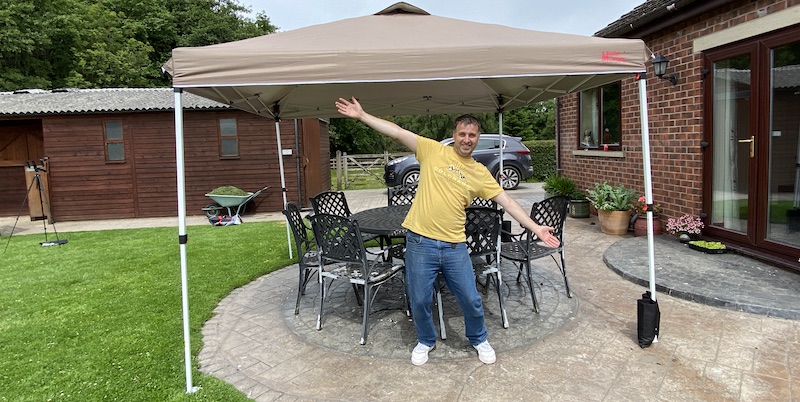
Pop-up gazebos are a fantastic option for those who want to have a temporary outdoor shelter that can easily be set up and taken down when needed. These structures typically have a canopy top made of fabric and a steel or aluminum frame that can be collapsed and stored in a carry bag. In this article, we will take a closer look at what makes pop-up gazebos such a popular choice for outdoor events, camping, and more.
One of the main advantages of pop-up gazebos is their portability. Whether you are going to the beach, attending a trade show, or hosting a backyard party, pop-up gazebos are lightweight and easy to transport. They can be set up quickly and without any special tools, making them an excellent option for those who want to save time and effort.
Additionally, pop-up gazebos are very versatile in terms of their functionality. They can be used for a wide range of outdoor activities, from picnics and barbecues to weddings and special events. Since they are available in different shapes, sizes, and colors, pop-up gazebos can easily be customized to suit your specific needs and personal preferences.
Another benefit of pop-up gazebos is that they offer protection from the sun and rain. The canopy top can be made of various materials, such as polyester, nylon, or PVC, and can provide shade and shelter from light rain or wind. Some pop-up gazebos even come with removable walls or mosquito netting to keep insects and other pests at bay.
When it comes to maintaining pop-up gazebos, they require minimal upkeep. The fabric top can be cleaned with a mild detergent and water, and the frame can be wiped down with a damp cloth to remove any dirt or debris. If you plan to store your pop-up gazebo for an extended period, make sure it is completely dry to prevent mold or mildew growth.
In conclusion, pop-up gazebos are an excellent choice for those who want a temporary outdoor shelter that is easy to set up, transport, and store. With their versatility, portability, and weather-resistant properties, pop-up gazebos can provide a comfortable and functional outdoor space for any occasion, from a small gathering to a large event.
Permanent Gazebos
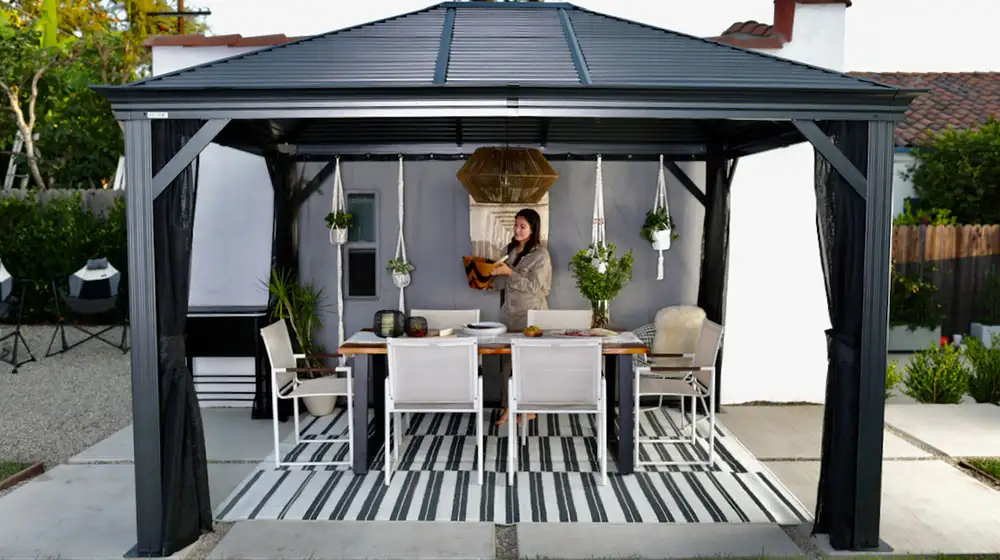
Permanent gazebos are outdoor structures that are designed to provide a long-lasting and durable solution for outdoor living spaces. Unlike pop-up gazebos, permanent gazebos are built to withstand inclement weather and strong winds, and they are designed to be a permanent fixture in your backyard.
There are different types of permanent gazebos available on the market, and they come in various styles, materials, and sizes. One of the most popular types of permanent gazebos is the hardtop gazebo, which features a sturdy metal roof that provides excellent protection from the elements.
Another type of permanent gazebo is the wooden gazebo, which is constructed of high-quality wood materials such as cedar, pine, or redwood. Wooden gazebos are an excellent option for those who want a natural-looking structure that blends seamlessly with their backyard space.
When it comes to building a permanent gazebo, there are a few factors to consider. One of the most important is the type of deck or patio you have in your backyard. If you have a concrete patio, you may need to use a masonry screw to anchor the gazebo posts securely. If you have a wooden deck, you will need to use special screws and metal straps to secure the gazebo to the deck surface.
Another important factor to consider when building a permanent gazebo is the wind strength in your area. If you live in an area with high wind speeds, you may need to use weight bags to anchor the gazebo legs or install the gazebo footings in concrete holes that are several inches deep.
Ultimately, a permanent gazebo can be a beautiful addition to your backyard space, providing a comfortable and stylish outdoor living area that can be used for years to come. With proper maintenance, a permanent gazebo can last for many years, providing an excellent return on your investment and enhancing your outdoor living experience.
Wooden Gazebos
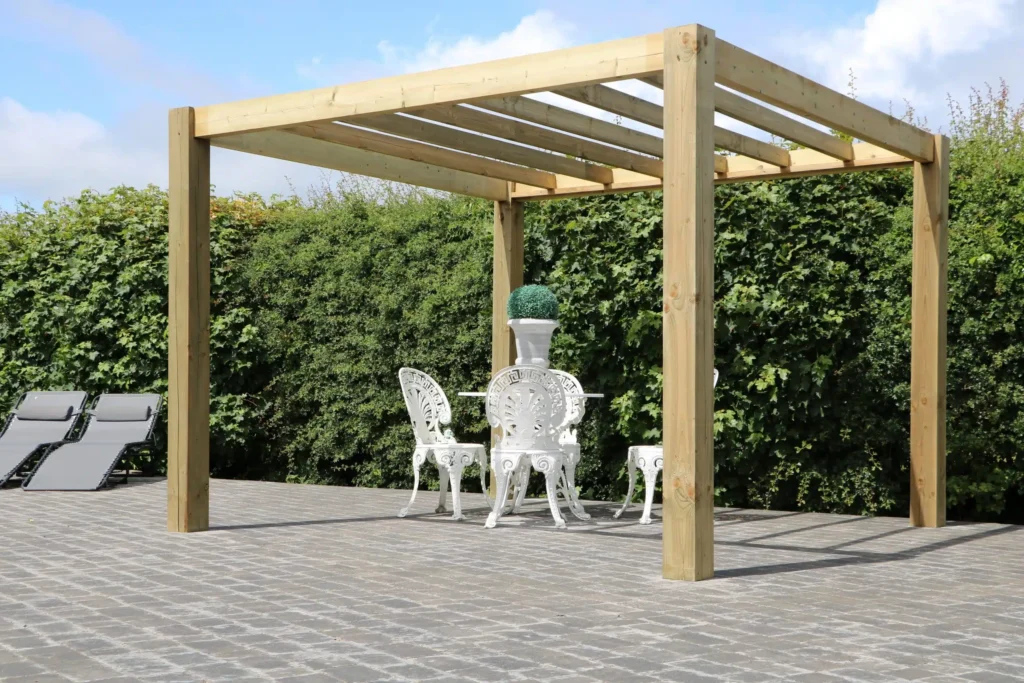
Wooden gazebos are a popular choice among homeowners who want to add an elegant and natural-looking structure to their backyard. These gazebos are typically made of high-quality wood materials such as cedar, pine, or redwood, which offer durability and longevity.
One of the main benefits of wooden gazebos is their versatility. They can be designed and styled to fit a wide variety of outdoor spaces and personal preferences. Whether you want a small and intimate gathering spot or a larger and open structure for entertaining guests, there is a wooden gazebo that will suit your needs.
In addition to their aesthetic appeal, wooden gazebos also offer practical benefits. They provide shade and shelter from the sun, rain, and other inclement weather conditions, making them a great addition to any outdoor living space. They can be designed with additional features such as screens, curtains or doors to provide extra protection from the elements and privacy from the surrounding area.
When it comes to building a wooden gazebo, there are several factors to consider. First and foremost is the type of wood to use. Cedar, for example, is a popular choice for its natural resistance to rot and insect damage, its attractive color and texture, and its durability. Pine is another popular choice, as it is less expensive than cedar but still provides a natural-looking structure.
Another important consideration is the style and design of the wooden gazebo. Some gazebos are designed with open sides and a flat roof, while others may have a pitched roof with shingles or tiles. Depending on your personal style and the overall aesthetic of your backyard, you can choose a design that complements your existing outdoor space.
In terms of installation, building a wooden gazebo usually involves digging post holes, setting footings, and securing the structure to a solid foundation. This can be done with a post hole digger, concrete footings, or even with special screws and metal straps if you are attaching the gazebo to a wooden deck.
Overall, a wooden gazebo is a great choice for those looking to add a permanent structure to their backyard that is both functional and aesthetically pleasing. Whether you want a small and intimate gathering space or a larger and more elaborate structure, a wooden gazebo can provide shade and shelter while adding a touch of elegance to your outdoor living area.
Metal Gazebos
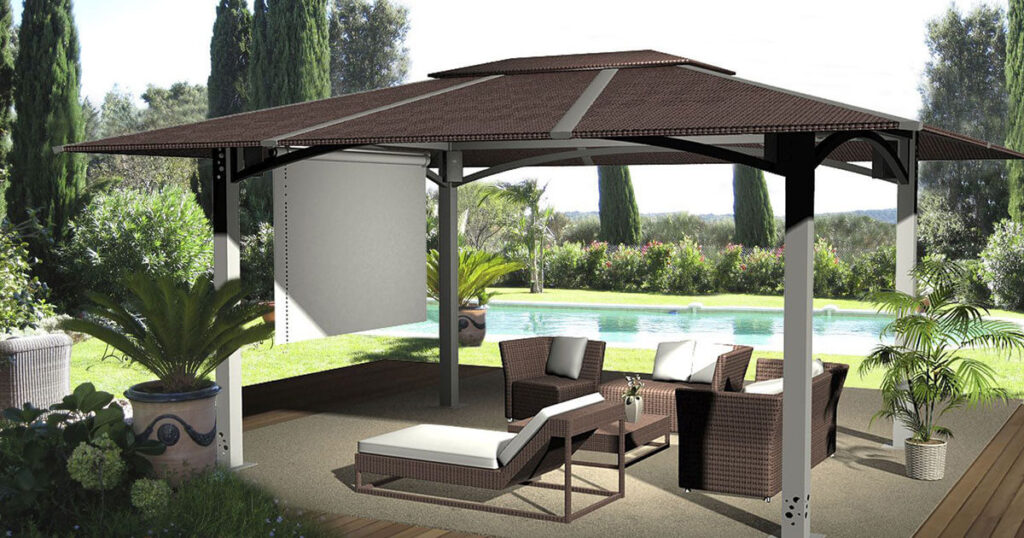
Metal gazebos offer a durable and long-lasting outdoor structure option for those looking for a permanent solution to their outdoor living space. These gazebos are often made from aluminum or steel and offer a sleek and modern design that can complement a variety of outdoor spaces.
One benefit of metal gazebos is their resistance to the elements. Unlike wooden gazebos, metal structures are less susceptible to rot, insect damage, and warping over time. This makes them a great option for those living in wet or humid climates.
Another benefit of metal gazebos is their stability in strong winds. While it’s important to securely anchor any outdoor structure, metal gazebos offer an extra level of stability due to their weight and durability. This makes them a great option for those living in areas with frequent inclement weather.
When it comes to the design of metal gazebos, there are a variety of options available. Some gazebos feature a hardtop design, with a solid aluminum or steel roof that provides extra protection from the sun and rain. Others may have a soft-top design, with a canopy or fabric roof that can be easily removed or replaced.
Installation of a metal gazebo typically involves setting up a sturdy foundation and securing the structure in place with screws and bolts. While this may take some time and effort, the result is a stable and secure structure that can provide years of enjoyment.
Overall, metal gazebos offer a durable and stylish option for those looking to enhance their outdoor living space. With their resistance to the elements and stability in strong winds, metal gazebos can provide a permanent solution for those looking to create a backyard oasis.
Portable Gazebos
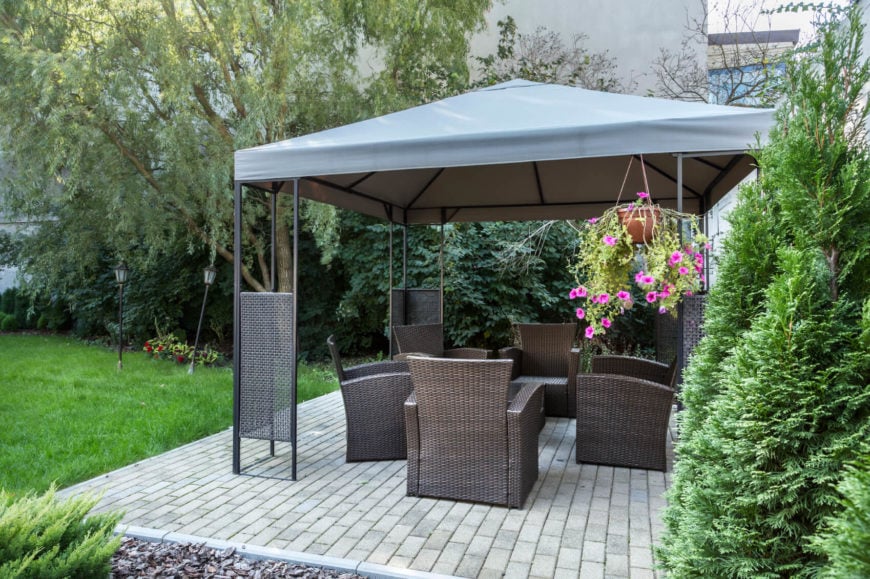
Portable gazebos are a great addition to any outdoor living space. These structures are easy to set up and take down, making them ideal for those who want to create a temporary outdoor gathering space. Portable gazebos come in a variety of styles, sizes, and materials, so finding the right one to fit your needs should be no problem.
One of the biggest advantages of a portable gazebo is its mobility. These structures are designed to be moved from one location to another, so you can set up a temporary outdoor living space wherever you need it. They are ideal for events such as outdoor parties, barbecues, weddings, and other gatherings.
Portable gazebos are also very easy to set up. Most come with a frame that can be assembled quickly using snap-lock connectors and adjustable legs. The roof is usually attached with Velcro, making it easy to remove or replace when needed. With a little bit of practice, it’s possible to have a portable gazebo up and running in no time.
Another advantage of a portable gazebo is its durability. Most models are designed to withstand moderate weather, such as slight wind or light rain. Some models even come with weight bags or anchoring systems to secure the structure in place in high wind or rain. However, it’s important to note that portable gazebos are not suitable for use in extreme weather conditions.
When choosing a portable gazebo, it’s important to consider the size of the structure and the material it’s made from. Some models are small and lightweight, making them ideal for solo use or small gatherings. Others are larger and heavier, designed to accommodate larger groups of people. In terms of material, most portable gazebos are made from polyester or nylon, with a steel or aluminum frame.
In conclusion, a portable gazebo is a versatile and convenient addition to any outdoor living space. These structures are easy to set up and take down, making them ideal for temporary outdoor gatherings. They are also durable and designed to withstand moderate weather conditions, making them a great investment for anyone looking to entertain outdoors. With so many different models available on the market, it should be easy to find a portable gazebo that meets your personal preferences.
Preparation for Installing a Gazebo on a Patio
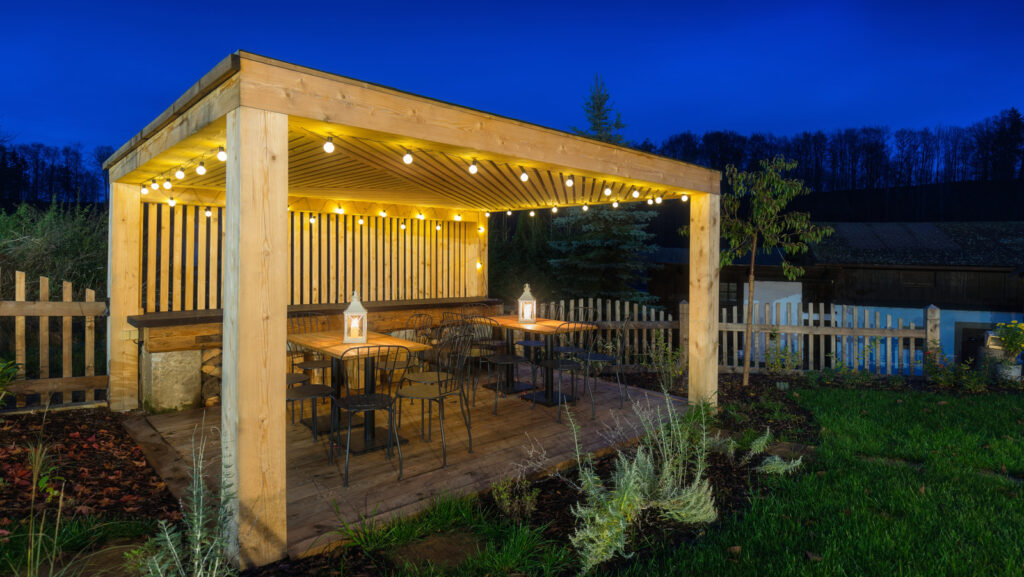
Installing a gazebo on a patio can be a great way to create a comfortable and shaded outdoor living space. However, it’s important to properly prepare for the installation process to ensure that the gazebo is stable and secure. Here are some steps to take when preparing to install a gazebo on a patio:
1. Consider the type of patio: Before you begin, take a closer look at your patio. Is it made of concrete, pavers, or wood decking? The material of your patio will determine the type of screws or anchors you’ll need to secure the gazebo in place.
2. Choose the right type of gazebo: There are numerous types of gazebos available, ranging from pop-up designs to permanent structures. Consider your personal preferences and the climate in your area when choosing the right type of gazebo for your patio.
3. Read the manufacturer’s instructions: Before you begin the installation process, make sure to carefully read the manufacturer’s instructions. This will give you a better understanding of the tools and materials you’ll need, as well as the specific steps required to install the gazebo.
4. Gather necessary tools and materials: In addition to the gazebo itself, you’ll need a variety of tools and materials to install it. This may include a post hole digger, masonry screws or anchors, a rubber mallet, a drill, and a flathead screwdriver.
5. Prepare the site: Clear any debris or objects from the area where you’ll be installing the gazebo. If you’ll be installing the gazebo on a concrete patio, use a power washer to clean the area and allow it to dry completely.
6. Install the frame: Begin by assembling the frame of the gazebo according to the manufacturer’s instructions. When attaching the legs to the patio, make sure to use the appropriate screws or anchors for your patio’s material.
7. Install the roof and accessories: Once the frame is secure, carefully attach the roof and any additional accessories, such as curtains or netting. Make sure to use proper safety precautions if you’ll be working at heights.
By taking the time to properly prepare for the installation process, you can enjoy a comfortable and secure outdoor living space for years to come.
Measure the Area Where You Want to Install the Gazebo
Before you begin the installation process for your gazebo, it’s important to measure the area where you want to install it. This will ensure that the gazebo fits perfectly in your outdoor living space, and will also prevent any issues or complications during the installation process.
To measure the area, start by marking out the exact spot where you want to install the gazebo. Use a measuring tape to measure the length and width of this spot, and record these measurements on a piece of paper.
You’ll also want to measure the height of the area, taking into account any obstacles like trees or overhangs that could impact the placement of your gazebo. Measure from the ground up to the approximate height you want the gazebo to be.
Once you have these measurements, you can compare them to the size of the gazebo you want to install. Consider factors like the width and height of the gazebo, as well as any overhanging sections like a hardtop gazebo.
It’s important to remember that you’ll need enough space around the gazebo to comfortably move and access the area. You’ll also want to consider the safeness of the gazebo in terms of how much distance from the nearest objects is recommended.
Finally, if you’re unsure about the size of gazebo you need for your space, err on the side of caution and go for a slightly smaller option. This will reduce the risk of over-crowding your outdoor living space, and will make the installation process much easier.
With these tips in mind, measuring the area where you want to install your gazebo should be a breeze. It may take some time and effort to get everything exactly right, but it’s worth it to ensure that your new gazebo fits perfectly in your outdoor living space and provides you with endless hours of relaxation and enjoyment.
Use Weight Bags or Sandbags to Stabilize the Legs of the Gazebo
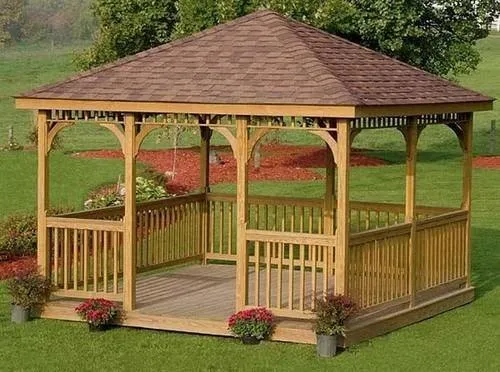
When it comes to setting up an outdoor gazebo, stability is key. Whether you are planning to use it for entertaining guests, a backyard wedding, or simply as a peaceful retreat space, it’s important that your gazebo stays secure and stable throughout any inclement weather.
One effective way to stabilize the legs of your gazebo is to use weight bags or sandbags. These bags are designed to sit on top of each leg of the gazebo, providing a counterbalance to keep it steady and prevent it from tipping over.
Weight bags or sandbags can be purchased from most outdoor living retailers and usually come in sets of four. They are designed to be filled with sand or other heavy materials, and typically have a strap that can be adjusted to fit around the leg of the gazebo.
To use weight bags or sandbags to stabilize your gazebo, simply fill each bag with sand and place it on top of the leg of the gazebo. Then, adjust the strap until it is securely fastened to the leg of the gazebo.
It’s important to note that weight bags or sandbags are not a permanent solution for stabilizing your gazebo. If you are looking for a permanent solution, you may need to consider more heavy-duty options like masonry screws or metal straps.
However, weight bags or sandbags are an effective option for temporary or semi-permanent installations, such as pop-up gazebos or backyard events. They are easy to set up and can be stored away when not in use.
Overall, using weight bags or sandbags is an affordable and simple way to ensure the stability of your outdoor gazebo. With a little bit of effort, you can enjoy a safe and secure outdoor living space that can withstand slight winds or heavy plant pots.
Make Sure You Have All Necessary Tools and Materials Ready Before Installation Begins
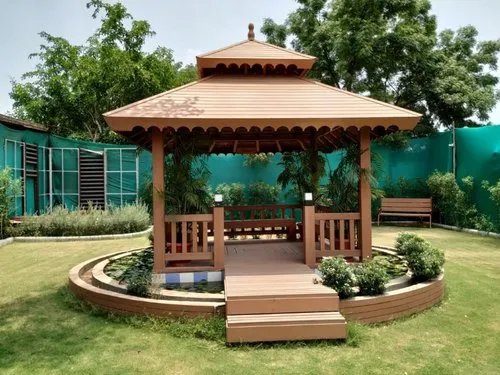
Installing a gazebo in your backyard can be an exciting and fulfilling experience. It not only enhances your outdoor living space but also provides a cozy spot to relax or entertain guests. However, before jumping into the installation process, it is important to ensure that you have all the necessary tools and materials readily available. Here are a few reasons why:
Efficiency: When you have all the required tools and materials at hand, it saves you valuable time and effort during the installation process. You don’t have to waste time searching for the right tools or borrowing them from your neighbor. By being organized, you can complete the installation quickly and efficiently.
Safety: Installing a gazebo can be a risky job, especially if you don’t have the right tools. If you try to improvise or use makeshift materials, it increases the likelihood of accidents or injuries. So, it’s best to use proper tools and materials to ensure your safety and the safety of those around you.
Professional finish: When you have all the necessary tools and materials for installation, you can achieve a professional finish. The gazebo will look clean, neat, and secure. This will not only enhance the overall aesthetics of your outdoor living space but also increase the property value.
To ensure a smooth installation process, it’s important to prepare all the necessary tools and materials beforehand. Gather tools such as a post hole digger, rubber mallet, flat head screwdriver, and special screws that are required for your type of gazebo installation. In addition, ensure that you have all the necessary materials like weight bags, screws, and metal straps.
If you’re unsure about the type of gazebo you’re installing, it’s best to consult with a professional or refer to the manufacturer’s guide. Following the instructions and ensuring that you have all the necessary tools and materials will make the installation process stress-free and ultimately lead to a successful outcome. With a little preparation and patience, you can transform your backyard with a beautiful and functional gazebo.
Installing a Temporary or Pop-up Gazebo on Your Patio
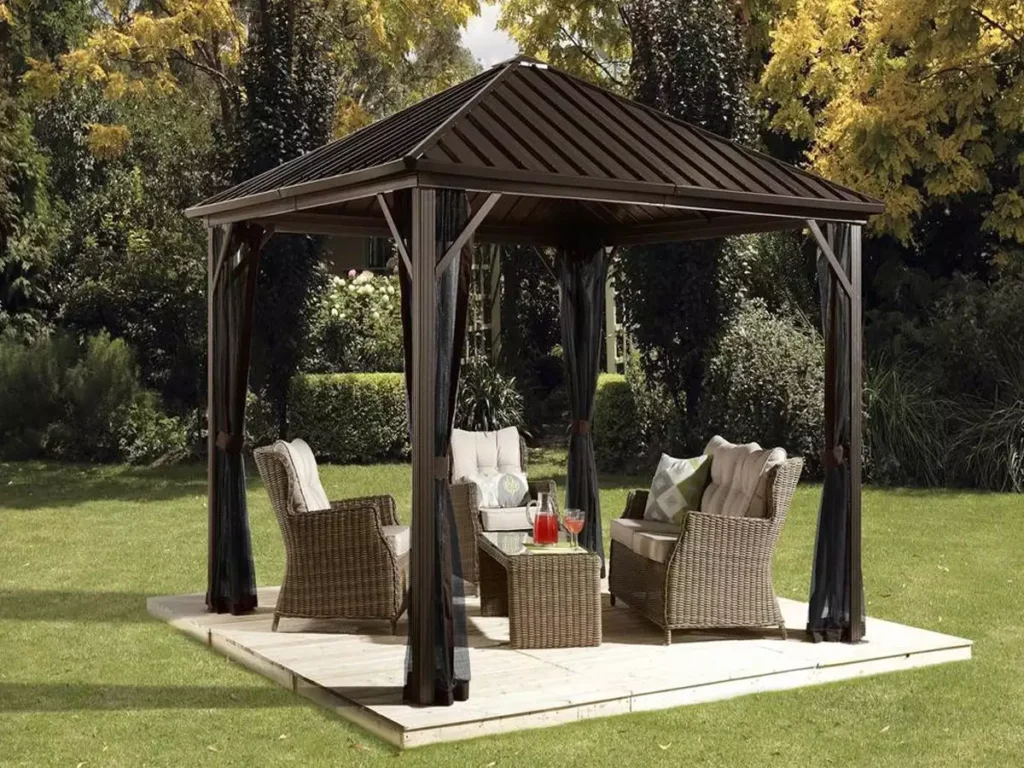
If you’re looking to add a little extra space to your outdoor living area, a temporary or pop-up gazebo is a great option. Not only do they provide shelter from the sun and rain, but they can also add a decorative touch to your patio. Installing a temporary or pop-up gazebo is a relatively easy process, but it does require the use of certain tools and materials.
To begin, choose the location for your gazebo. Make sure it is on a level area of your patio and away from heavy plant pots or other potential hazards. Next, unfold the gazebo and lay it out flat. Check to see if there are any damages or missing pieces before you start assembly.
Once you’ve inspected your gazebo, start assembling the frame. This may require the use of a rubber mallet to securely fit the pieces together. Some temporary or pop-up gazebos come with metal straps that can be used to help hold the frame in place.
Once the frame is assembled, it’s time to put on the cover. This may require assistance from another person, as the cover may be heavy or awkward to handle on your own. Be sure to line up the cover properly to ensure a secure fit.
Finally, add weight bags or use anchors to secure the gazebo to your patio. This will keep it from tipping over in inclement weather or slight winds. For added stability, you can also attach the gazebo legs to your patio using masonry screws or other secure methods.
When installing a temporary or pop-up gazebo, it’s important to keep in mind that it is not a permanent structure. These types of gazebos are designed to be used temporarily and are not built to withstand heavy winds or extreme weather conditions. If you live in an area with high wind speeds or heavy snowfall, a permanent gazebo may be a better option.
In conclusion, installing a temporary or pop-up gazebo on your patio can enhance your outdoor living space and provide some much-needed shelter. By following these simple steps and using the appropriate tools and materials, you can have your gazebo installed in no time.
Step 1: Place Your Tent Poles or Posts in Position
Whether you’re setting up a tent for a camping trip or a gazebo for a backyard gathering, the first step is to place your tent poles or posts in position. This may seem like a simple task, but it’s important to do it correctly to ensure the stability and safety of your outdoor structure.
When choosing a location for your tent or gazebo, it’s important to consider the ground surface. If the ground is uneven or sloped, it may be difficult to set up your structure properly. Look for a level area that is free from rocks, roots, and other potential hazards.
Once you have found a suitable location, begin by positioning the poles or posts in the ground. If you’re setting up a tent, start with the center pole and work your way outwards. For a gazebo or other outdoor structure, position the posts in the corners first and then add the remaining posts to create a square or rectangular shape.
As you position the poles or posts, use a level to ensure that they are straight and upright. This will help to prevent your structure from leaning or collapsing in windy conditions. If the ground is too hard to push the poles or posts into place by hand, use a post hole digger to create holes for them.
Once the poles or posts are in position, use a rubber mallet or hammer to pound them into the ground firmly. This will ensure that they are secure and stable, even in heavy winds or inclement weather.
Remember to leave enough space between the posts or poles to accommodate the size of your structure. This will ensure that your tent or gazebo is the correct size and shape, and that there is enough space for your guests to move around comfortably.
In conclusion, placing your tent poles or posts in position is the first and most important step when setting up an outdoor structure. By following these simple tips, you can ensure that your structure is stable, secure, and safe for all of your outdoor activities.
Step 2: Secure the Tent Poles or Posts with Weight Bags or Sandbags
One important factor in setting up your tent or gazebo is ensuring that it is stable and secure. While setting the poles or posts into the ground is a great first step, there are additional measures you can take to ensure that your structure stays upright and secure in any weather conditions.
One popular option for securing tent poles or posts is to use weight bags or sandbags. These are specially designed bags that can be filled with sand or other heavy materials, and then placed around the base of your structure to add extra weight and stability.
To use weight bags or sandbags, begin by filling them with sand or other heavy materials. Once they are full, place one at each corner of your tent or gazebo, positioning them as close to the poles or posts as possible.
If you are worried about the weight bags or sandbags detracting from the aesthetic of your outdoor living space or backyard, you can also look for bags that are designed to blend seamlessly into your decor and surroundings.
Another benefit of weight bags or sandbags is that they can be easily removed and stored when not in use. This makes them a great option for temporary or pop-up structures that may need to be moved or stored away at times.
While weight bags or sandbags can be a great addition to your tent or gazebo setup, it’s important to remember that they are just one of many options for securing your structure. Other popular options include using metal straps or special screws to attach the posts or poles to the ground, or even digging permanent holes and using masonry screws to secure the structure in place.
Ultimately, the method you choose will depend on your personal preferences, the type of gazebo or tent you are using, and the conditions in your outdoor space. Whether you choose to use weight bags or sandbags or another method entirely, taking the time to ensure that your structure is secure will help to make your outdoor living space a safe and enjoyable place to relax and entertain.

